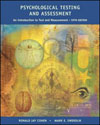 |
1 |  | 
Compare projective techniques to objective methods of personality assessment. What are the features of each? Discuss differences in administration, scoring, and interpretation. What are the advantages and limitations of each? |
|  | |
 |
 |
2 |  | 
Discuss the term "objective" in objective methods of personality assessment. Discuss the various meanings of the term "objective." |
|  | |
 |
 |
3 |  | 
Discuss the different types of stimuli that are used to create projective tests (words, pictures, inkblots, etc.). What type(s) of stimuli might contribute to more valid tests? |
|  | |
 |
 |
4 |  | 
How might you go about exploring the technical adequacy (i.e., reliability and validity) of a test such as the Rorschach? |
|  | |
 |
 |
5 |  | 
How does the validity evidence provided for tests such as the TAT, the Rorschach, and figure-drawing tests "stack up" with respect to the standards presented in the Standards? |
|  | |
 |
 |
6 |  | 
Is it possible to "fake good" on the Rorschach? On the TAT? On sentence-completion tests? |
|  | |
 |
 |
7 |  | 
What do you think accounts for the popularity of projective methods (in spite of a lack of psychometric soundness)? |
|  | |
 |
 |
8 |  | 
What are the assumptions on which projective methods are based? Are these assumptions supported by the research to date? |
|  | |
 |
 |
9 |  | 
How might figure drawings be particularly valuable in the personality assessment of young children or illiterates? |
|  | |
 |
 |
10 |  | 
Discuss whether the Rorschach is a test, a method, a technique, or something else. |
|  | |
 |
 |
11 |  | 
Summarize the different approaches to scoring the Rorschach. |
|  | |
 |
 |
12 |  | 
Discuss why the authors characterize the evaluation of the psychometric soundness of the Rorschach as "a tricky business." |
|  | |
 |
 |
13 |  | 
Discuss why the Rorschach is one of the most frequently taught projective techniques in graduate psychology programs. Characterize the arguments of those who support its clinical use and those who believe it has no place in clinical practice. |
|  | |
 |
 |
14 |  | 
Characterize the arguments that support the use of the TAT versus those who argue against its psychometric soundness. |
|  | |
 |
 |
15 |  | 
Discuss the issue of reliability and validity for the TAT. What types of reliability and validity estimates are appropriate for use with the TAT? What types of reliability and validity estimates are inappropriate? |
|  | |
 |
 |
16 |  | 
Discuss the psychometric soundness of figure drawings. |
|  | |
 |
 |
17 |  | 
Discuss the assumptions referred to in the section "Projective Methods in Perspective." |
|  | |
 |
 |
18 |  | 
Discuss the impact of situational variables on the results of projective tests. |
|  | |
 |
 |
19 |  | 
This chapter discusses situational performance measures including situational stress tests (such as the type of test that might be required for employment as a stockbroker). What other types of situational stress tests can you envision? How might a situational stress test be designed to screen psychologists for a position as an instructor of a course in tests and measurements? |
|  | |
 |
 |
20 |  | 
Have you had experience with any of the tools of personality assessment discussed in Chapter 12? What about a polygraph? Based on the material presented in the text, do you agree or disagree with the decision not to allow the results of polygraph tests to be introduced as evidence in court? Why or why not? |
|  | |
 |
 |
21 |  | 
Discuss the limitations of behavioral observation. How might these limitations be minimized? Identify problems other than those listed in the text associated with behavioral observation as an assessment technique. |
|  | |
 |
 |
22 |  | 
Discuss the statistical or actuarial approach versus the clinical approach to personality assessment. |
|  | |
 |
 |
23 |  | 
Compare and contrast the "sign" approach to assessment versus the "sample" approach. What are the features of each? Give examples of each. Discuss their relationship to the traditional and behavioral views of personality. |
|  | |
 |
 |
24 |  | 
Compare and contrast the different types of behavioral assessment, including behavior rating scales and psychophysiological methods. How are rating scales categorized? |
|  | |
 |
 |
25 |  | 
Discuss the various uses of role-play in assessment as compared to teaching and therapy. Provide examples. |
|  | |
 |
 |
26 |  | 
How might the reliability and validity of behavioral observation methods be determined? How do these methods compare with other types of personality assessment including projective tests and objective personality tests? |
|  | |
 |
 |
27 |  | 
What factors affect the reliability and validity of behavioral measures (such as definition of the target behavior, contrast effect, reactivity)? |
|  | |
 |
 |
28 |  | 
Discuss the advantage of generalizability theory as opposed to classical test theory in determining the reliability of behavioral measures. |
|  | |
 |
 |
29 |  | 
Discuss the various "tools" of behavioral assessment. |
|  | |
 |
 |
30 |  | 
Discuss the problems inherent in rating scales for use in personality assessment. |
|  | |
 |
 |
31 |  | 
Give some examples of self-monitoring and discuss its advantages and limitations in clinical work. What factors inherent in self-monitoring will impact reliability and validity of this approach? |
|  | |
 |



 2002 McGraw-Hill Higher Education
2002 McGraw-Hill Higher Education